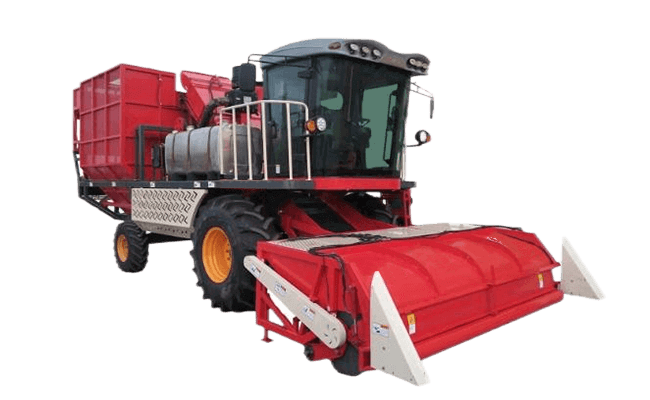IIn our daily lives, chili peppers are not just a crop but a “star ingredient” that brings countless dishes to life with its vibrant flavors. Whether it’s the fiery spice in a hot pot, a touch of heat on a seared steak, or the depth it adds to a simple stir-fry, chili peppers deliver a unique taste that’s simply irresistible. It’s not just a seasoning—it’s a sensation that lingers on the palate, leaving you craving more.During harvest season, ensuring that chili peppers are gathered fresh and of the highest quality is essential to bringing out the best in every spicy dish. A high-efficiency chili pepper harvester becomes the true guardian of this flavor, helping farmers to harvest quickly and precisely. This way, we can continue to enjoy the finest chilies, fueling the flavors of our favorite spicy meals.


When selecting a chili pepper harvester, you can focus on farm size and specific harvesting needs. Large-scale farms benefit most from self-propelled or multi-functional harvesters, as these models are equipped to cover wide areas continuously, often with automated control systems for fast, high-efficiency harvesting. Medium- and small-sized farms might consider tractor-mounted harvesters, which offer good value and suit flat terrains, while small, hand-guided models provide flexibility and are ideal for small or hilly plots. It’s essential to consider the machine’s processing capacity, fruit loss rates, and adaptability to ensure strong performance across various terrains and crop densities.
In the following sections, we’ll cover how chili pepper harvesters work, explore the unique features of different models, and discuss key performance aspects. Additionally, we’ll share practical tips for selection and operation, helping you make the best decision for your farm.
Contents
- 1 Principle of the Chili Pepper Harvester
- 2 Types of Chili Pepper Harvesters and Their Advantages
- 3 Performance and Efficiency: Chili Pepper Harvester Operation
- 4 Costs and Return on Investment: Analysis of Chili Harvester Expenses
- 4.1 1. What is the price range for chili harvesters, and how much do different models vary?
- 4.2 2. What are the long-term maintenance costs and supply expenses?
- 4.3 3. Which option is more cost-effective, renting or purchasing?
- 4.4 4. What are the fuel or power consumption rates for chili harvesters? Are there energy-efficient models?
- 5 Conclusion
Principle of the Chili Pepper Harvester

Fruit Picking and Collection
The chili pepper harvester’s main component is the picking system, which generally includes a series of rollers, cutting blades, or flexible grippers. As the harvester moves, it removes chili peppers from the plants using vibrations, gripping, or cutting. Certain models have automated sensors to identify ripe fruits, avoiding immature peppers and increasing picking accuracy.
Conveyance and Separation
Once picked, the chili peppers travel through a conveyor system—typically using belt or screw conveyors—to the separation system. Here, the peppers are separated from stems, leaves, and other debris. This initial cleaning step, achieved through drum screening or airflow separation, ensures that the peppers remain pure by removing most impurities.
Cleaning and Debris Filtering
After initial separation, the peppers often go through a more detailed cleaning process. Many chili harvesters feature cleaning units that use airflow or mesh screens for secondary filtering, which removes dirt and fine leaf fragments. This added step ensures pepper quality and prevents contamination. Cleaning intensity can be adjusted to match different field and crop conditions.
Collection and Loading
After cleaning, the chili peppers move to a collection bin or storage box. The size and structure of the storage vary by model, and some advanced harvesters come with automatic loading systems, which directly transfer the peppers to a transport vehicle, reducing manual handling.
Control System
Modern chili pepper harvesters are equipped with smart control systems to simplify and enhance operations. Operators can adjust picking speed, harvesting height, and cleaning intensity based on crop density, soil conditions, and terrain through a control panel or remote. Certain high-end models also offer GPS navigation and autopilot functions, enabling precise path planning and autonomous operation, which significantly boosts efficiency.
Anti-Clogging and Adaptability Design
The chili pepper harvester includes anti-clogging features to handle slippery or clay-filled soils and other challenging conditions. This design usually includes self-cleaning rollers and wide conveyor channels, ensuring smooth operation in various soil types and weather conditions.
Types of Chili Pepper Harvesters and Their Advantages
In various harvesting scenarios, each type of chili pepper harvester brings unique benefits. For large-scale farms or commercial operations, self-propelled and multifunctional harvesters often offer the best solutions by efficiently covering large areas and delivering a high-speed harvest experience. For small- and medium-sized farms, you can flexibly choose between tractor-mounted or hand-push models based on field conditions. This targeted selection can greatly enhance efficiency, reduce labor needs, and improve the quality of your chili harvest. By choosing the right model based on your planting area, terrain, and budget, you can achieve higher profits during the harvest season.
Self-Propelled Chili Pepper Harvester
- Advantages: The self-propelled chili harvester has an independent power system for easy movement and features an integrated design for picking, conveying, separating, and collecting peppers. Its stable structure adapts well to challenging terrains like slopes or rugged fields. Many self-propelled models also include smart control systems, allowing operators to adjust parameters through a control panel for optimized harvest results.
- Best Applications: This model is ideal for large-scale chili farms, especially where high efficiency and extended continuous operation are required. Self-propelled chili harvesters are widely used in large planting bases and commercial farms, providing high-speed and efficient harvesting during peak season.
Tractor-Mounted Chili Pepper Harvester
- Advantages: The tractor-mounted harvester, powered by the tractor, offers a more affordable option with high cost-effectiveness, suitable for medium-scale operations. While it may not match the strength of self-propelled models in picking and cleaning, it effectively processes chili peppers and works well on relatively flat fields. Its simple structure also makes maintenance and operation easy.
- Best Applications: This type suits small to medium farms with limited budgets, especially those with flat terrain and moderate field sizes. It’s particularly suitable for mid-sized farms aiming to balance the needs of multiple crops by providing reliable harvesting efficiency at a lower cost.
Small Hand-Push Chili Pepper Harvester
- Advantages: Hand-push chili harvesters are small, simple to operate, and highly flexible, especially for small fields and scattered plots. This model is affordable and easy to maintain, generally featuring basic picking and collecting functions suitable for small-scale farms. Additionally, hand-push models consume less fuel and are easy to transport.
- Best Applications: Hand-push harvesters work well for small family farms, compact planting areas, and mountainous regions with scattered plots. They’re perfect for individual farmers or small farms with modest yields, offering a cost-effective solution for routine harvests.
Multifunctional Combined Harvester
- Advantages: The multifunctional combined harvester can be adapted to other crops besides chili by adjusting certain components. This type usually includes interchangeable picking, cleaning, or separation units to handle different crops. For farmers seeking a versatile solution, these harvesters offer exceptional value. Many multifunctional models also feature large collection bins, minimizing the need for frequent unloading and boosting efficiency.
- Best Applications: Combined harvesters suit medium- to large-scale farms with diverse crops, particularly those growing chili, soybeans, corn, and other varieties. Ideal for mixed cropping systems, this type allows flexible operations and significantly reduces equipment investment costs.
Performance and Efficiency: Chili Pepper Harvester Operation
The performance and efficiency of a chili pepper harvester directly impact the speed, workflow, and final quality of the harvest. For farmers aiming to boost harvest efficiency, understanding the machine’s real-world operation is essential. Here are several key questions about chili harvester performance and efficiency to help you choose the best model.
How much area does it cover per hour?
The harvesting efficiency of a chili harvester varies by model, field conditions, and crop density. Generally, a large self-propelled chili harvester can cover around 6-10 acres per hour, making it ideal for large-scale farms. A medium-sized, tractor-mounted chili harvester processes about 4-6 acres per hour, which suits medium-sized farms well. For smaller, hand-push harvesters, efficiency typically ranges from 1-3 acres per hour, which works well for smaller plots.
How much chili weight can it handle per load?
The capacity of a chili harvester per operation depends on the machine’s hopper size and design. Standard models usually feature hopper capacities of 200-500 kg, which meet most regular needs. High-efficiency or large machines can handle up to 700-1,000 kg, significantly reducing the need for unloading, which suits large-scale operations well. A tractor-mounted model generally handles around 200-400 kg of chilis, while a small, hand-push model handles 100-200 kg per load.
Does the harvester clog often during operation, and how does it prevent clogs?
During harvest, chili harvesters can be affected by plant stems, weeds, and soil, which may lead to blockages in the intake or picking system, especially on damp or debris-heavy fields. To reduce clogging, many modern harvesters include anti-clogging systems such as optimized intake channels, reverse-rotation rollers, and even automatic cleaning functions in some models.
Will the harvester miss peppers on low or lodged plants?
Low or lodged chili plants can make harvesting challenging, potentially leading to missed fruits or damage. To address this, many high-end chili harvesters, such as Minnuo Group’s 240-horsepower self-propelled harvester, include adjustable height functions, which automatically adapt to various plant heights. Additionally, some models come with auxiliary pick-up devices, which help minimize missed fruits on lodged plants and maintain the quality of the harvest.
Costs and Return on Investment: Analysis of Chili Harvester Expenses

1. What is the price range for chili harvesters, and how much do different models vary?
Chili harvesters generally range from a few thousand to several tens of thousands of dollars, depending on the model and features. Basic hand-push or small-mounted models typically cost around $1,500-$3,000, making them ideal for smaller operations. Mid-sized, tractor-mounted harvesters range from $4,000-$8,000, balancing performance with affordability. For large-scale harvesting needs, a self-propelled harvester usually falls between $15,000-$30,000, with high-end, smart models going over $30,000.
2. What are the long-term maintenance costs and supply expenses?
The main maintenance costs for a chili harvester include regular replacement of wear parts, lubricants, and cleaning supplies. Common wear parts, such as picking gears, belts, chains, and screens, usually require annual maintenance costs ranging from $500 to $1,500, depending on the work environment and usage frequency. The cost of lubricants and cleaning agents generally ranges from $100 to $200 per year, varying with workload.
3. Which option is more cost-effective, renting or purchasing?
For smaller farms or those harvesting less frequently, renting a chili harvester may be a more economical choice. Rental rates vary by region and equipment type, generally costing around $5-$15 per acre, or $200-$500 per day per machine. Renting allows you to avoid a large initial investment, which suits those with occasional needs. However, for larger farms with frequent harvesting requirements, owning a harvester is more cost-effective in the long run. Although the initial outlay is higher, ownership allows flexible use anytime, with better long-term cost efficiency. Large farms that buy their equipment can often recoup the cost within a few harvest seasons, enjoying the flexibility and reliability of having their own harvester.
4. What are the fuel or power consumption rates for chili harvesters? Are there energy-efficient models?
The energy consumption of chili harvesters varies with the type and workload. Self-propelled diesel models generally consume 1-2 gallons per hour, costing around $5-$10 per hour. Tractor-mounted harvesters use slightly less fuel, at 0.5-1 gallon per hour, or about $2.5-$5 per hour. Electric harvesters, on the other hand, consume around 1-2 kilowatt-hours per hour, costing approximately $0.10-$0.30 per hour (depending on local electricity rates), making them both energy-efficient and environmentally friendly. Minnuo equipment offers models with energy-saving designs that intelligently adjust consumption during operation, reducing fuel use and emissions. These energy-efficient machines are ideal for farmers seeking long-term operational cost savings and an eco-friendly solution.


